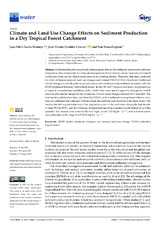Climate and Land Use Change Effects on Sediment Production in a Dry Tropical Forest Catchment
Autor
García Montoya, Juan Pablo
Giráldez Cervera, Juan Vicente
Vanwalleghem, Tom
Editor
MDPIFecha
2021Materia
SEDD modelSediment transport
Soil erosion
Land-use change
ENSO
Colombia tropical basin
METS:
Mostrar el registro METSPREMIS:
Mostrar el registro PREMISMetadatos
Mostrar el registro completo del ítemResumen
Understanding the natural and anthropogenic drivers that influence erosion and sediment transport is a key prerequisite for adequate management of river basins, where, especially in tropical catchments, there are few direct measurements or modeling studies. Therefore, this study analyzed the effect of human-induced land-use changes and natural ENSO (El Niño-Southern Oscillation) related changes in rainfall patterns on soil erosion and catchment-scale sediment dynamics with the SEDD (Sediment Delivery Distributed) model. In the 393 km2 Tonusco river basin, representative of tropical, mountainous conditions, daily rainfall data were used to quantify changes in rainfall erosivity and satellite images for the evaluation of cover factor changes between 1977 and 2015. The final model combined soil loss, calculated by RUSLE, with a sediment routing-based delivery ratio, that was calibrated and validated with data from the sediment load recorded at the basin outlet. The results detected a great reduction of the vegetation cover in the catchment during the last decade of from 79.5 to 29.5%, and the influence of important runoff and erosion events linked to La Niña episodes. Soil erosion rates were locally very high, of over 120 Mg ha−1yr−1, and sediment yields were estimated at the range of 6.17–8.23 Mg ha−1yr−1.

